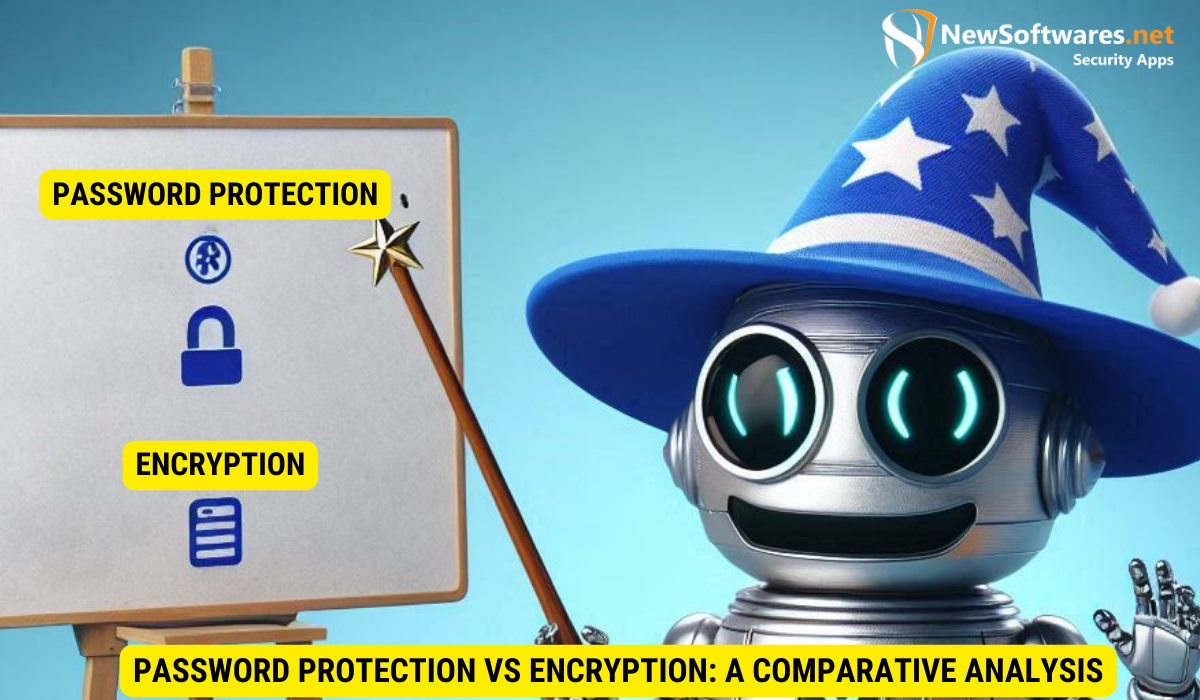Password protection and encryption are both security measures, but they function differently:
Password Protection:
• Acts like a gatekeeper to restrict access to data.
• Requires a password to view or modify the protected information.
• Does not alter the actual data, which remains in its original form.
Encryption:
• Transforms data into a coded form that appears as gibberish without the decryption key.
• Provides a higher level of security, as encrypted data is unreadable without the correct key or password.
• Often used in combination with password protection for enhanced security.
In today’s digital age, where our personal and sensitive information is constantly at risk, it’s crucial to understand the fundamental concepts and methods of safeguarding our data. Two commonly used approaches for data security are password protection and encryption. While both serve the purpose of protecting information, they differ in their execution and level of security they provide. Together, we will delve into the intricacies of password protection and encryption, examine their similarities and differences, explore the importance of using both methods together, and provide guidelines for choosing the appropriate data protection techniques.
Defining Password Protection
Password protection is a widely utilized method where access to data is restricted through the use of passwords. It involves setting up a unique combination of characters or words that serve as the key to unlock the secured data. This method acts as the first line of defense against unauthorized access, as it requires individuals to know the correct password in order to gain access. While password protection may seem straightforward, it is essential to understand the basics to ensure optimal security.
The Basics of Password Protection
At its core, password protection involves creating a strong password that is difficult to guess or crack. It is recommended to use a combination of uppercase and lowercase letters, numbers, and special characters to maximize complexity. Additionally, it is advisable to avoid using easily guessable information such as personal details or dictionary words in passwords. By following these basic guidelines, users can enhance the security of their passwords and deter unauthorized individuals from gaining access to their data.
The Role of Passwords in Data Security
Passwords play a significant role in ensuring data security. They act as a barrier between our sensitive information and potential threats. Implementing password protection adds an extra layer of security, preventing unauthorized access to our valuable data. Without the correct password, individuals attempting to access the protected information are thwarted, significantly reducing the risk of data breaches and unauthorized use.
Furthermore, password protection is not limited to just personal data. In today’s digital landscape, businesses and organizations heavily rely on password protection to safeguard their confidential information. From financial records to customer databases, passwords are the gatekeepers that keep sensitive data out of the wrong hands.
Moreover, password protection is not a one-time setup. It requires regular maintenance and updates to ensure the highest level of security. This includes changing passwords periodically, especially after any potential security breaches or suspicious activities. Additionally, enabling multi-factor authentication, where users need to provide additional verification methods such as a fingerprint or a unique code, further strengthens the security of password-protected accounts.
Exploring Encryption
Encryption, on the other hand, is a more comprehensive and complex technique for securing data. It involves the process of converting plain text information into an unreadable format, known as ciphertext. The ciphertext can only be deciphered using a decryption key, ensuring that even if the encrypted data is intercepted, it remains unreadable to unauthorized individuals.
What is Encryption?
Encryption is a mathematical process that uses complex algorithms to transform data into a format that is unreadable without the corresponding decryption key. This ensures that sensitive information remains confidential and protected, even if it falls into the wrong hands. Encryption can be applied to various forms of data, including emails, files, and even entire databases.
How Encryption Enhances Data Security
Encryption provides a high level of security by rendering the data unreadable to anyone without the proper decryption key. Even if hackers or unauthorized individuals manage to access the encrypted data, they cannot make sense of it. This additional layer of security ensures the confidentiality and integrity of our sensitive information, providing peace of mind in an increasingly connected world.
Password Protection vs Encryption: A Comparative Analysis

While both password protection and encryption serve the purpose of protecting data, they differ in various aspects. Let’s examine the similarities and key differences between these two methods.
Similarities Between Password Protection and Encryption
Both password protection and encryption aim to secure data and prevent unauthorized access. They serve as layers of defense, making it difficult for attackers to gain access to sensitive information. Additionally, both methods can be implemented in combination, providing even stronger security.
Key Differences Between Password Protection and Encryption
Although password protection and encryption have similar goals, they differ in their execution and level of security. Password protection focuses on restricting access to data through the use of passwords, while encryption transforms data into unreadable ciphertext. While passwords can be cracked through various methods, encryption provides a higher level of security by making the data unreadable even if breached. It is crucial to understand these differences to determine the appropriate method for data protection.
The Importance of Using Both Password Protection and Encryption
While password protection and encryption offer individual layers of security, their combination provides enhanced data protection. Employing both methods is essential for safeguarding sensitive information effectively.
Complementing Password Protection with Encryption
By implementing both password protection and encryption, sensitive data becomes doubly protected. Passwords act as the first line of defense, preventing unauthorized access, while encryption ensures that even if passwords are compromised, the data remains unreadable. Together, these methods create a formidable barrier against potential threats.
The Risks of Relying on One Method Alone
Relying solely on password protection or encryption can leave vulnerabilities in the overall data security. Passwords can be cracked or guessed, allowing unauthorized access to sensitive information. Similarly, encryption can be bypassed if the decryption key is obtained unlawfully. In order to mitigate these risks, it is crucial to utilize both methods symbiotically, minimizing the chances of data breaches and ensuring foolproof security.
Choosing the Right Protection for Your Data

With the vast array of data protection methods available, it can be challenging to choose the most suitable approach for your specific needs. Consider the following factors when selecting data protection techniques:
Factors to Consider When Choosing Data Protection Methods
- Sensitivity of Data: Evaluate the level of sensitivity and importance of the data to determine the appropriate protection measures required.
- Compliance Requirements: Ensure that the chosen data protection methods align with relevant regulatory compliance requirements.
- User Experience: Strive for a balance between security and usability to ensure a smooth user experience without compromising data protection.
- Scalability: Consider the scalability of the chosen data protection methods to accommodate future growth and increasing data volumes.
- Cost and Resources: Assess the financial implications and availability of resources required for implementing and maintaining the chosen data protection techniques.
Best Practices for Implementing Password Protection and Encryption
Implementing password protection and encryption requires careful consideration and adherence to best practices. Follow these guidelines:
- Use strong and complex passwords for optimal security.
- Regularly update and change passwords to minimize the risk of unauthorized access.
- Encrypt all sensitive data, regardless of its storage location.
- Maintain separate and secure backups of encryption keys to avoid potential loss or compromise.
- Regularly review and update security protocols to stay ahead of emerging threats and vulnerabilities.
Key Takeaways:
- Password protection restricts access to data through the use of passwords.
- Encryption transforms data into unreadable format to enhance security.
- Implementing both password protection and encryption provides optimal data security.
- Passwords and encryption complement each other to create a robust defense against unauthorized access.
- When choosing data protection methods, consider factors such as data sensitivity, compliance requirements, user experience, scalability, and cost.
FAQs
1. What is password protection?
Password protection is a method of securing data by setting up passwords that restrict access to the information.
2. How does encryption enhance data security?
Encryption renders data unreadable without the proper decryption key, thereby providing an additional layer of security in case of a breach.
3. Should I use password protection or encryption?
It is recommended to use both password protection and encryption together to ensure optimal data security.
4. How do I choose the right data protection methods?
Consider factors such as data sensitivity, compliance requirements, user experience, scalability, and cost when selecting data protection techniques.
5. How can I implement password protection and encryption effectively?
Implement strong and complex passwords, regularly update and change passwords, encrypt sensitive data, maintain secure backups of encryption keys, and regularly review and update security protocols.
Conclusion
In conclusion, understanding the differences between password protection and encryption is crucial for effectively safeguarding our data. While password protection creates a barrier to restrict access, encryption adds an additional layer of security by making data unreadable. Both methods offer individual benefits, but their combination provides optimal data protection. By carefully considering factors such as data sensitivity, compliance requirements, and user experience, individuals and organizations can select the most appropriate data protection techniques. Implementing best practices for password protection and encryption ensures robust security for our valuable information in an increasingly interconnected world.
